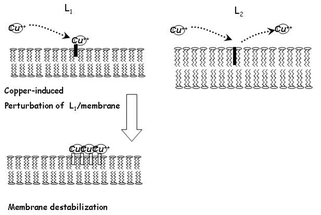The conversion of Prion (PrPc), a protein normally found on the outer surface of neurons, into an abnormal conformer (PrPsc) is a key molecular event in the pathogenesis of Prion diseases. Recent experimental observations support the hypothesis that an abnormal interaction of PrP with the lipid membrane might be involved in the conversion of PrPc into PrPsc. Particularly, a peptide with an amino acid sequence VNITIKQHTVTTTT corresponding to the second helical region of Prion, PrP 180–193, has been shown to form amyloid aggregates in water and to possess a copper-mediated toxicity to neurons. In the present work, the interaction of PrP 180–193 and its N-terminally acetylated and C-terminally amidated derivative with model membranes formed by dipalmitoylphosphatidylcholine (DPPC) was predicted by thermodynamic models and studied by differential scanning calorimetry (DSC). Thermodynamic predictions give negative values of ΔG only when the peptides transfer, in a structured form, from water to the interface region of the DPPC membrane. The DSC peaks referring to samples prepared according to two different protocols evidence remarkable differences. When the peptides are simply added to an aqueous suspension of the DPPC membrane only the blocked peptide inserts spontaneously; on the other hand when the segments are forced to insert into the membrane, by mixing lipids and peptides during the preparation of the membrane, a different behaviour is evidenced depending on the presence or absence of free charges at the ends of peptides. Our findings suggest a topological situation in which the hydrophobic part of the two peptides inserts into the membrane at a different depth as the copper effect on the complex membrane–peptide system clearly shows. These findings might have intriguing implications on the understanding of the molecular reasons for the neurotoxicity of this prion fragment.

